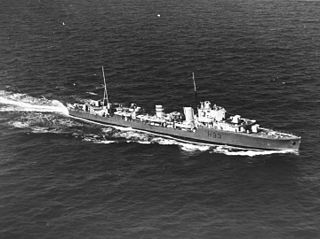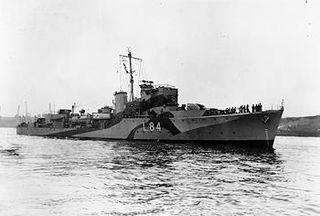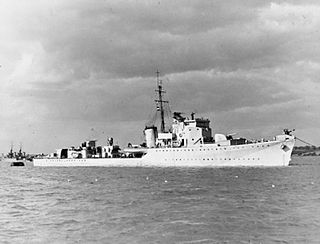
HMS Hereward, named after Hereward the Wake, was an H-class destroyer built for the Royal Navy in the mid-1930s. She was assigned to the Mediterranean Fleet before and the ship spent four months during the Spanish Civil War in mid-1937 in Spanish waters, enforcing the arms blockade imposed by Britain and France on both sides of the conflict. When the Second World War began in September 1939, the ship was in the Mediterranean, but was shortly transferred to the South Atlantic to hunt for German commerce raiders and blockade runners, capturing one of the latter in November. Hereward was transferred to the Home Fleet in May 1940 and rescued Queen Wilhelmina of the Netherlands after the Germans had invaded.

Operation Pedestal, known in Malta as Il-Konvoj ta' Santa Marija, was a British operation to carry supplies to the island of Malta in August 1942, during the Second World War.

The siege of Malta in World War II was a military campaign in the Mediterranean theatre. From June 1940 to November 1942, the fight for the control of the strategically important island of the British Crown Colony of Malta pitted the air and naval forces of Fascist Italy and Nazi Germany against the Royal Air Force (RAF) and the Royal Navy.

The Battle of the Mediterranean was the name given to the naval campaign fought in the Mediterranean Sea during World War II, from 10 June 1940 to 2 May 1945.

The Mediterranean and Middle East Theatre was a major theatre of operations during the Second World War. The vast size of the Mediterranean and Middle East theatre saw interconnected naval, land, and air campaigns fought for control of the Mediterranean, North Africa, the Horn of Africa, the Middle East and Southern Europe. The fighting lasted from 10 June 1940, when Italy entered the war on the side of Germany, until 2 May 1945 when all Axis forces in Italy surrendered. However, fighting would continue in Greece – where British troops had been dispatched to aid the Greek government – during the early stages of the Greek Civil War.

Operation Stoneage or Operation Stone Age was an Allied convoy operation to the Mediterranean island of Malta in the Second World War. To disguise the destination of the ships, some took on their cargo at Port Sudan in the Red Sea. The four ships of Convoy MW 13 sailed from Alexandria on 16 November, escorted by cruisers, destroyers and round-the-clock air cover from captured airfields in Egypt and Cyrenaica.

The Malta convoys were Allied supply convoys of the Second World War. The convoys took place during the Siege of Malta in the Mediterranean Theatre. Malta was a base from which British sea and air forces could attack ships carrying supplies from Europe to Italian Libya. Britain fought the Western Desert Campaign against Axis armies in North Africa to keep the Suez Canal and to control Middle Eastern oil. The strategic value of Malta was so great the British risked many merchant vessels and warships to supply the island and the Axis made determined efforts to neutralise the island as an offensive base.

HMS Sirius was a Dido-class light cruiser of the Royal Navy. She was built by Portsmouth Dockyard, with the keel being laid down on 6 April 1938. She was launched on 18 September 1940, and commissioned 6 May 1942.

HMS Hursley was a Second World War Type II Hunt-class escort destroyer of the British Royal Navy. She is the only Royal Navy ship to have carried this name. Hursley is a village in Hampshire. Commissioned in 1942, she served in the Mediterranean, before being transferred to the Hellenic Navy in November 1943 and renamed Kriti. She took part in the landings in Sicily, Anzio, and southern France, and remained in Greek service until 1959.

HMS Tartar was a Tribal-class destroyer of the Royal Navy that saw service in most of the naval theatres of World War II. She had an eventful career, eventually receiving the nickname 'Lucky Tartar' due to her numerous escapes from dangerous situations. She was one of only four from the sixteen Royal Navy-operated Tribal-class destroyers to survive the war.
HMSAS Parktown was a minesweeping whaler of the South African Naval Services that was sunk during the Second World War. She was built as the whaler Southern Sky for the Southern Whaling and Sealing Company in 1929 and sold in 1936 to the Union Whaling Company, acquiring the new name Sidney Smith. She was requisitioned on 8 August 1940 as HMSAS Parktown and was converted to sweep magnetic mines. She arrived at Tobruk on 10 June 1942 just in time to take part in the evacuation of Allied forces. She was the last ship to leave Tobruk harbour prior to its capitulation to German forces on 20 June 1942. Parktown embarked 60 troops and took a tug in tow outside the harbour. Her reduced speed led to her being attacked by German E-boats, most probably German E-boats from Derna. Gunfire from the motor boats destroyed the bridge, ruptured the boiler, killed or wounded half of the men on board and led to on-board ammunition exploding, causing her to finally stop moving and setting the ship on fire. She was finally sunk on the evening of 21 June 1942 by an Allied MTB which had arrived to pick up survivors.

Operation Portcullis was the voyage of the Allied Convoy MW 14 with supplies to Malta from Port Said in Eygpt during the Second World War. The convoy followed the success of Operation Stoneage which had raised the Siege of Malta. Four merchant ships were escorted to Malta by seven destroyers of the 12th Destroyer Flotilla, supported by three cruisers of the 15th Cruiser Squadron and three destroyers from Alexandria.

The second HMS Hambledon was a Hunt-class destroyer of the Royal Navy in commission from 1940 to 1945. She was a member of the first subgroup of the class, and saw service throughout World War II.

The second HMS Exmoor (L08), ex-HMS Burton, was a Hunt-class destroyer of the Royal Navy in commission from 1941 to 1945. She was a member of the second subgroup of the class, and saw service during much of World War II. She later served in the Royal Danish Navy as HDMS Valdemar Sejr.

HMS Venomous (ex-Venom), was a Modified W-class destroyer of the British Royal Navy that saw service in the Russian Civil War and World War II.

The Battle of the Campobasso Convoy was a naval engagement between three British Royal Navy destroyers and an Italian Regia Marina torpedo boat which took place off Cape Bon in the Mediterranean sea on the night of 3/4 May 1943. The Italians were escorting the 3,566 gross register ton (GRT) freighter Campobasso to Tunisia.

HMS Hurworth was a Second World War Type II Hunt-class escort destroyer of the British Royal Navy. She spent most of her career in the Mediterranean. She was lost to a mine in the Aegean Sea in 1943.

The Battle off Zuwarah was a naval night encounter during the Second World War. The battle took place in Libyan waters between the Royal Navy and the Regia Marina. An Italian flotilla of small minesweepers and auxiliary vessels evacuating Tripoli was destroyed by two British destroyers.

HMS Oakley was a Type II Hunt-class destroyer of the Royal Navy. She was originally to have been named Tickham, however she was renamed after her sister ship Oakley was transferred to Poland and was renamed ORP Kujawiak (L72). She entered service in May 1943, carrying out convoy escort, patrol and anti-shipping attacks for most of the rest of the Second World War. She was adopted by the Civil community of Leighton Buzzard in Bedfordshire as part of Warship Week in 1942. In 1957, she was sold to the West German Navy, serving as a training ship for the German Naval Gunnery school until scrapped in 1972.

















